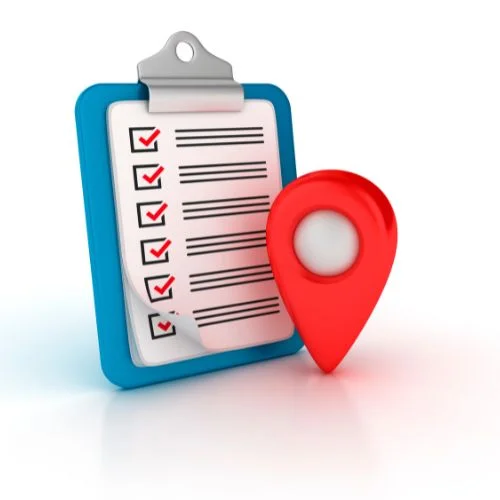
Companies everywhere use an asset tracking system to help them keep control of their assets. The system that they use may allow them to stay in full control of their assets at all times. At itemit, we proudly offer you the opportunity to track all of your assets with ease. Providing you with a range of features, organised asset tracking can become more transparent and faster.
Let’s take a look at how exactly companies keep track of their assets.
What is Asset Tracking

Asset tracking refers to the method of monitoring and managing physical assets with technology: RFID tags, QR codes, barcodes, and GPS. This allows a firm to know in real time where their assets are, what condition and status they are in, and whether their number has decreased or increased. Asset tracking is putting systems in place that manage company equipment, machinery, and tools to reduce instances of theft and loss.
It gives an asset a digital record that it carries throughout its life. The record may include maintenance schedules, location history, and information about users, among others, and this makes the approach important for companies as they do asset management.
Why You Should Use Asset Tracking
Key reasons you should adopt asset tracking in your company include an immense list of benefits accruing to the business, regardless of size. Here are some of those advantages:
- Enhanced Visibility: Asset tracking allows you to have complete visibility regarding the location of your assets, who uses them, and for what purpose. It helps optimise assets for maximum use.
- Reduced Costs: Recording assets and usage could highlight where you do not have to spend extra money. You won’t be so likely to buy extra equipment when what you already have will work, nor will you replace items that have merely been misplaced.
- Improved Maintenance: With notifications for scheduled maintenance or repairs, you are able to keep equipment running and prolong the life cycle of your assets. You’ll catch problems before they become expensive to fix.
- Better Security: Knowing the location of your assets at any given moment enhances security and reduces theft and loss. An asset-tracking system adds another level of accountability within an organisation.
- Regulatory Compliance: Many industries have set regulations on how equipment should be tracked and managed. Asset tracking helps comply with these set standards in industries; hence, avoidance of penalties and fines.
Generally, asset tracking is a very important tool in the management of a company’s equipment, thereby offering companies a competitive advantage in their asset management.
The Evolution of Asset Tracking
Asset tracking has undergone significant modifications since its inception. Initially, companies relied on manual systems, which included spreadsheets and even written logs, for tracking their assets. These were time-consuming, prone to errors, and required limited or no real-time insight whatsoever.
Asset tracking started using barcodes and scanners as the technology progressed, for which more comprehensive data is preferred. Indeed, barcodes made it easier to record business assets, but again, it is a manual approach.
Nowadays, companies track assets with advanced technologies like RFID, QR code, GPS, and cloud-based software. All the modern techniques allow tracking automatically; it means tracking the assets in real-time without human interference. RFID tags and GPS trackers brought a revolution in resource tracking in companies by providing accuracy, visibility, and efficiency in tracking.
Cloud-based asset tracking solutions, of which itemit is one, took it further and enabled businesses to access their asset data from anywhere at any time. Now, the evolution of asset tracking has so far enabled companies to trace their assets with organized consistency while enabling efficiency, security, and cost savings.
Tracking The Location
One of the easiest ways to keep track of assets is to track every asset’s location. Knowing where all of your assets are at all times can make life easier. At the touch of a button, you and your team can see where some or all of your equipment, machinery, and tools are.
At itemit, we make tracking a breeze. When you use our asset tracking system, we will send you some RFID tags or QR codes. It’s these tags and codes that allow you to track the location of all of your assets. All that you need to do is affix a code or tag to those assets you’d like to track. Then, you can create a digital profile and track an asset’s location. This approach makes it clear how to track equipment efficiently and effectively within your company. This type of company asset tracking allows for more efficient company equipment management. When you have accurate information about where your assets are, you can make better decisions about how to track equipment in a company.

Improving The Maintenance Schedule
From time to time, equipment, machinery, and tools can fail to work as well as they should. When this occurs, it makes sense to send the asset for maintenance. However, it is not always clear which tool, for example, needs to be repaired. The good news is that itemit can help with this.
Should something go wrong with a machine, users can send an alert to the maintenance team asking them to repair it. Our asset tracking system also allows you to set up a maintenance schedule. Sending out alerts when a piece of equipment needs its yearly check, for example, ensures equipment is in better working order.
Regular maintenance checks help to keep equipment functioning efficiently, prevent unexpected breakdowns, and ultimately save costs. Having an effective company tools and equipment policy that includes scheduled maintenance ensures that your company’s valuable resources are managed effectively.
Checking Equipment In And Out
Another very useful feature that comes with itemit’s asset tracking system is the ability to check equipment in and out. It makes sense to track some equipment and tools more closely than others. This is particularly the case if some equipment is valuable. With the ability to check equipment in and out, it is possible to see who has which laptop, for example, and when they checked it out. By using asset tracking systems, you can also understand how to keep track of tools and equipment effectively. You can also see when a tool was checked back in, so you know it’s where it should be.
This feature ensures that there’s an extra layer of security surrounding some or all of your assets. It allows management to keep a close eye on who is using the assets and when. With company asset tracking, you can easily keep track of who has what and whether it’s in good condition when returned.
Understanding How Many Assets You Have
When you know how many assets you have, you can adjust your spending accordingly. For example, ABC Builders may need more than 200 hammers. However, it’s unlikely that they would know how many hammers they have if they had not created a digital profile for each one.
With this information given to you, you can spend more or less in specific areas. Funds can be diverted elsewhere, allowing other departments to thrive. When you have control of your assets in this way, better business decisions can be made.
Having a clear understanding of company asset tracking is essential. It allows you to prevent unnecessary purchases, reduce waste, and use resources more efficiently. Knowing how to track equipment in a company is key to maintaining a well-organized business.
Improving The Level of Security

When you know what assets you have, where they are, and who is using them, you automatically improve security. Our tracking system takes the guesswork out of tracking all of your assets. Within just a few moments, you can track your most important assets. You can have control over who uses which assets, and you can even see which ones need to be repaired.
The enhanced security provided by tracking solutions is invaluable to any company. With a clear record of every item, fewer assets are likely to go missing or be stolen. When you implement company asset tracking with a reliable system, security concerns can become a thing of the past.
Tracking Equipment With Audits
Auditing assets within your firm is another way of record keeping. Regular auditing provides great insight into whether these assets are well utilised and accounted for. Tracking assets this way ensures that no equipment gets misplaced or lost.
RFID tags and QR codes combine with digital audits. You can conduct an automated scan instead, collecting data without having to count each asset manually. This makes company equipment management a whole lot easier and faster to handle; you will hence be able to track your equipment across the company without any hustle.
Enhancing Productivity and Efficiency
You understand productivity and efficiency when you know the location of your assets and who is using them. Because employees won’t have to look around anymore for the equipment they need, they can get it instantly with the help of asset tracking. This simply reduces downtime while maintaining a smooth workflow.
With a capable asset tracking system, your business will increase levels of productivity and efficiency. When your team is able to access all the tools they need fast, it is easier for them to do their work; this is another great reason for implementing a solution for tracking equipment across your company.
Reducing Operational Costs
An effective system of asset tracking reduces operational costs through better asset utilisation and a reduction in waste. With an accurate overview of your company’s assets, you will make sure those assets are put to use in the best possible way. That means fewer useless assets are lying idle, and you will be less likely to spend money to replace or stock more than what is required.
Keep your machinery and equipment well serviced and reduce downtime to save on repair costs. This will also help you avoid frequently costly emergency replacements. Company asset tracking means better resource utilisation, reduced operational costs, and increased profitability.
Compliance and Regulatory Requirements
Most industries have strict regulatory requirements around equipment and asset management. Non-compliance with these may lead to fines, penalties, and sometimes reputational damage. Companies will be ensured of remaining compliant with relevant regulations through the use of an efficient tracking system for assets.
The asset tracking software helps in managing detailed records of the assets for maintenance history, usage data, and audit trails. This information can be invaluable to prove your compliance during inspections or audits. Knowing equipment tracking in a company keeps you at a better advantage in terms of meeting industry standards and incurring regulatory compliance.
Streamlining Asset Lifecycles
A very important feature of asset tracking in a company is how the asset in question goes through its full lifecycle, from acquiring it to eliminating it. In simple terms, each and every piece of equipment and tool has an operating life. By monitoring the lifecycle of the particular equipment, you can determine when and how to repair, replace, or retire it.
With an asset tracking system, you can trace the age, usage, and condition of each asset. You can tell when an asset nears the end of its useful life, and you can plan for its replacement in due time. This way, you proactively act to avoid surprise interruptions of your operation and ensure that assets are always in good working order.
Customisable Reporting and Insights

Perhaps the most convincing feature of the asset tracking system is the generation of customised reports and insights. You can have in-depth reporting to analyse asset usage, maintenance history, and overall efficiency. These reports can help you identify patterns, make data-driven decisions, and facilitate continuous improvement over your asset management processes.
Customisable reports will also allow you to track the KPIs associated with asset utilisation, maintenance costs, and downtime. This level of visibility equips you with information that will guide strategic decisions concerning the general goals and objectives set by your company. Knowing how to track equipment companywide allows you to optimise asset performance and make your whole business run more smoothly.
Use itemit’s Asset Tracking System
If you need to use an asset tracking system that’s reliable and full to the brim with useful features, itemit can help. We can make tracking assets easy thanks to the way that our software works. Our tool-tracking software is designed to help companies efficiently monitor and manage all their valuable resources. You can have much more control over all of your assets 24-hours a day, 7 days a week.
Talk to us today about how our asset tracking system can help you. You can reach our knowledgeable team of asset tracking experts at: team@itemit.com. Alternatively, you could choose to sign up for our 14-day free trial so you can get started right away. You do not have to give us any of your payment information, and you could start tracking your assets sooner than you think. Simply complete the form below to get started.

Try itemit
Choose a better way to track your assets. Start your free 14-day trial now!
Frequently Asked Questions
What specific types of businesses benefit the most from using asset tracking systems like itemit?
Companies that have a large number of physical assets benefit greatly from company asset tracking systems like itemit. This includes industries such as construction, healthcare, manufacturing, and logistics. Businesses that rely heavily on equipment, tools, or machinery can reduce costs, improve efficiency, and enhance security by using company asset tracking.
What are the costs associated with implementing and maintaining an asset-tracking system using itemit?
The costs associated with implementing and maintaining a company asset tracking system with itemit vary depending on the scale of your operations and the specific features you require. Generally, costs include the initial purchase of tracking tags (RFID or QR codes), subscription fees for the tracking software, and potential maintenance costs. However, the cost savings in terms of reduced loss, better maintenance, and increased productivity often outweigh the initial investment.
What are the security measures involved in protecting sensitive asset data in these systems?
itemit employs multiple security measures to ensure the protection of sensitive asset data. This includes data encryption, secure cloud storage, user authentication, and access control to restrict data visibility to authorized personnel only. Regular software updates and security audits are conducted to maintain a high level of data protection, ensuring your company asset tracking information remains secure.

Keep Learning
itemit Blog
Tips, guides, industry best practices, and news.
Key Benefits of Implementing Remote Inventory Management
[lwp_divi_breadcrumbs font_icon="5||divi||400"...
Your Business Can Benefit From Asset Tracking: Here’s Why
Your business can benefit from using asset tracking software. Want to know how? Read this post now to find out so your business can thrive!
You Can Reduce Asset Downtime: Here’s How
Downtime can cause many issues. Using pre-emptive maintenance to help you avoid downtime is the way forward. Read this post to find out how!


